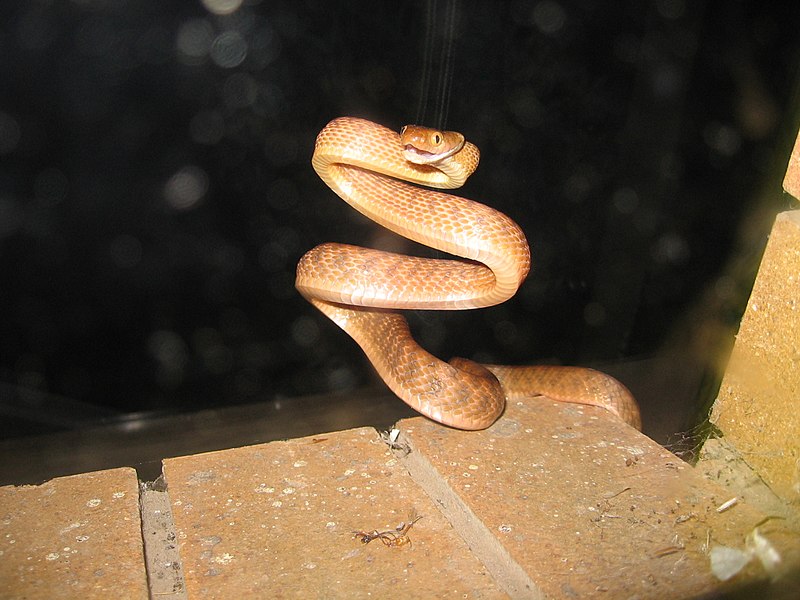A recent article (Jan. 2009) in Physiological and Biochemical Zoology has shed light on why spitting cobras nearly always hit the eyes of whatever creature they are aiming for, be it secretary bird (a predator), gnu (a trample hazard) or person.
Perfect Aim Not Needed
Utilizing high speed photography and EMG tests, researchers established that the snakes contract their head and neck muscles just before ejecting venom. The contractions rotate the head and jerk it sharply from side to side, so that the venom forms a complex geometric spray pattern as it approaches its target. As long as aimed in the general direction of the face, the venom contacts the adversary’s eyes nearly 100% of the time.
Keeping Zookeepers on Their Toes
I have worked closely with several types of spitting cobras. Like many Elapids (cobras and their relatives), they are alert and quick-moving, and seem, at least on the surface, to be quite intelligent. These traits, combined with their ability to both bite and “spit”, renders them quite a handful in captivity, and they provide much fodder for zookeepers’ tales.
Perhaps He Thought They Needed Exercise?
In one very bizarre incident from my Bronx Zoo days, a visitor held his son up so that the child could kick in the glass of an exhibit housing 3 black-necked spitting cobras (Naja nigricollis)! As might be expected, the breaking glass caused a great deal of agitation to both the snakes and some of the other visitors…I say “some of” because nearly as many people were pushing towards the exhibit as were running away (those wacky New Yorkers!). Fortunately, all emerged unscathed, and the snakes were recovered quickly.
Cobra Hunting to Start the Day
Another zoo adventure began when, still bleary-eyed after a few mugs of espresso very early one spring morning, I discovered that 3 red spitting cobras (Naja pallida) had vacated their holding cage overnight. The ancient plastic goggles I used around spitters were fine for exhibit work, but rendered me nearly blind in the dim, cluttered recesses of the reptile house’s basement and storage areas. Lifting the goggles briefly to peek under something was terrifying, but so was leaving them on and seeing only unidentifiable shadows.
One colleague, goggles perched on his forehead, spied a snake and grabbed it with tongs, neglecting to lower the goggles in the excitement. Fortunately, the trapped serpent vented its wrath by biting the tongs, and not by spitting at my partner’s face! After a few sweaty, suspense-filled hours, all 3 snakes were re-captured…whereupon I ordered new goggles!
I’ve also had run-ins with the spitting cobra’s much larger relative, the king cobra…please see my article A Close Call With a King Cobra http://blogs.thatpetplace.com/thatreptileblog/2008/06/ for more cobra tales.
Image referenced from Wikipedia, first published by LA Dawson, and shared under the Creative Commons Share Alike-2.5 License.
 That Reptile Blog – Reptile, Amphibian and Exotic Pet Care and Information
That Reptile Blog – Reptile, Amphibian and Exotic Pet Care and Information


 Snakes have a well-deserved reputation as escape artists and, once at liberty, they are nearly impossible to find. Almost always, the escapee shows up by accident, no matter how hard one searches – even quite large snakes can virtually disappear in relatively small areas (please see photo – the 16 foot long anaconda pictured there “vanished” in about 6 inches of water on the Venezuelan llanos; I took over an hour to find her despite “knowing” where she was!). However, there are a few tricks that can improve your chances of recapturing a lost pet…but first, if I may, a few related stories:
Snakes have a well-deserved reputation as escape artists and, once at liberty, they are nearly impossible to find. Almost always, the escapee shows up by accident, no matter how hard one searches – even quite large snakes can virtually disappear in relatively small areas (please see photo – the 16 foot long anaconda pictured there “vanished” in about 6 inches of water on the Venezuelan llanos; I took over an hour to find her despite “knowing” where she was!). However, there are a few tricks that can improve your chances of recapturing a lost pet…but first, if I may, a few related stories: Writing in the current issue of the journal Animal Behavior, researchers from the University of Grenada report that female Mexican lance-headed rattlesnakes frequently consume infertile eggs and non-living young after giving birth. This is said to be the first documented case of cannibalism among rattlesnakes (please see below for my observations, however). Interestingly, with a sole exception, the females did not consume young that were born alive, even though these remain inactive for several hours after birth, and appear (to us, at least!) to be dead.
Writing in the current issue of the journal Animal Behavior, researchers from the University of Grenada report that female Mexican lance-headed rattlesnakes frequently consume infertile eggs and non-living young after giving birth. This is said to be the first documented case of cannibalism among rattlesnakes (please see below for my observations, however). Interestingly, with a sole exception, the females did not consume young that were born alive, even though these remain inactive for several hours after birth, and appear (to us, at least!) to be dead. I had the wonderful opportunity of participating in the renovation of the Staten Island Zoo’s reptile house, former stomping ground of legendary snakeman Carl Kauffeld (known to all snake keepers as the author of Snakes, the Keeper and the Kept and Snakes and Snake Hunting).
I had the wonderful opportunity of participating in the renovation of the Staten Island Zoo’s reptile house, former stomping ground of legendary snakeman Carl Kauffeld (known to all snake keepers as the author of Snakes, the Keeper and the Kept and Snakes and Snake Hunting).